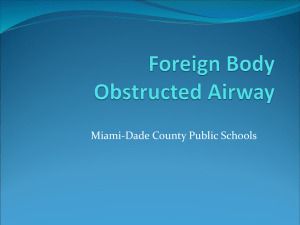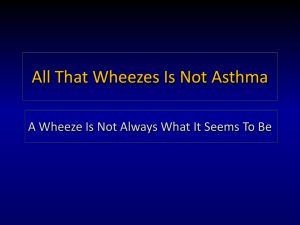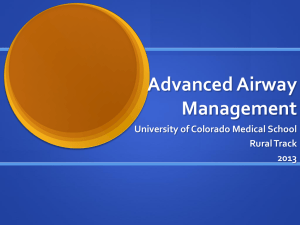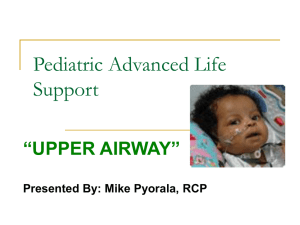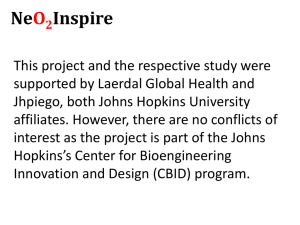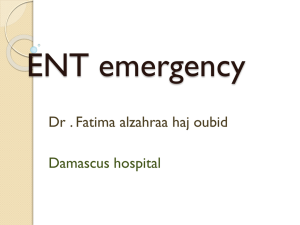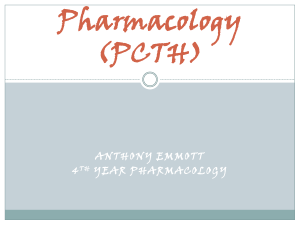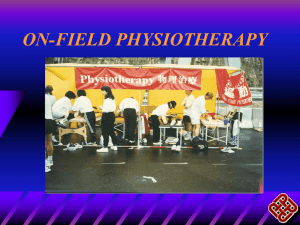anesthesia for common pediatric emergencies
advertisement
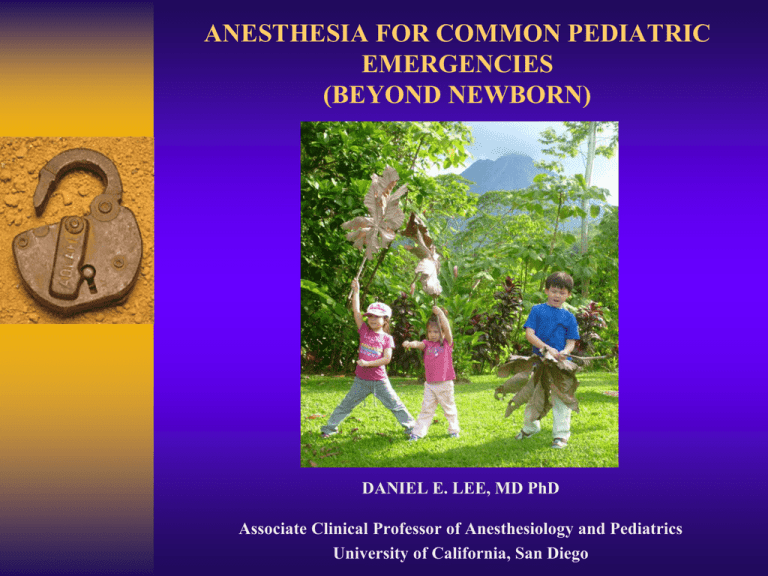
ANESTHESIA FOR COMMON PEDIATRIC EMERGENCIES (BEYOND NEWBORN) DANIEL E. LEE, MD PhD Associate Clinical Professor of Anesthesiology and Pediatrics University of California, San Diego PEDIATRIC PERIOPERATIVE RISK Pediatric Perioperative Cardiac Arrest registry (POCA) – 1.4 cardiac arrests per 10,000 instances of anesthesia – Cardiac arrest mortality of 26% – Age < 1 year and emergency status are independent predictors of mortality Unique Anesthetic Management Concerns – Smaller FRC, increased metabolic rate, more rapid desaturation with apnea – Often uncooperative, impacting upon ease of IV placement, preoxygenation, awake intubation, etc. – Infants and young children in particular may have unrecognized underlying disease that can affect response to anesthesia, e.g. cardiac or airway anomalies COMMON PEDIATRIC EMERGENCIES FOREIGN BODY ASPIRATION EPIGLOTTITIS PERITONSILLAR ABSCESS RETROPHARYNGEAL ABSCESS POST TONSILLECTOMY HEMORRHAGE HYPERTROPHIC PYLORIC STENOSIS FOREIGN BODY ASPIRATION Most common in toddler age group Presentation – Coughing or choking while eating – Persistent cough or difficulty swallowing – Wheezing or stridor Examination: locate level of obstruction – Stridor: esophageal FB at cricoid level – Severe obstruction/cyanosis: large FB trapped in glottis or trachea – Unilateral wheezing/air trapping: distal airway aspiration Foreign Body Aspiration Figure 1. A chest radiograph may appear normal during inspiration (A) following foreign body aspiration. A hyperinflated right lung and a leftward mediastinal shift during expiration (B) suggest a foreign body in the right mainstem bronchus. PEDIATRIC OTOLARYNGOLOGIC EMERGENCIES. Susan T. Verghese and Raafat S. Hannallah . Anesthesiology Clinics of North America 19 (2) : 237-256 FOREIGN BODY RETRIEVAL FOREIGN BODY ASPIRATION - II Preoperative Preparation – Timing • Emergency? (e.g. cyanosis, noxious substance) • Discuss with surgical specialist re: urgency and special needs – Premedication • Atropine 20 mcg/kg IV/IM: dries secretions, facilitates topical anesthesia, maintains heart rate. Anesthetic Induction • Sevoflurane or Halothane inhalation induction • Maintain spontaneous ventilation initially – Avoids need for positive pressure ventilation – May decrease risk of dislodging FB FOREIGN BODY ASPIRATION - III Anesthetic Maintenance – Deep Sevoflurane/Halothane, spontaneous ventilation, supplementation with propofol IV – Under deep anesthesia > direct laryngoscopy > supraglottic FB may be removed if visualized – Topical lidocaine spray (2-4%) to airway, max 3-5 mg/kg – Intermittent airway obstruction? • Supplemental IV propofol 50-200 mcg/kg/min – Excessive coughing with airway manipulation? • Supplemental topical tracheal lidocaine by surgeon • Short acting narcotic or paralytic. Then controlled ventilation via sideport of rigid bronchoscope or intermittently by mask. – Esophagoscopy needed? • First secure airway with endotracheal tube EPIGLOTTITIS Life-threatening airway emergency Less common since advent of Haemophilus Influenza type B vaccine Symptomatology occasionally mistaken for croup, a more common childhood airway problem. Misdiagnosis can be disastrous. EPIGLOTTITIS vs CROUP CROUP EPIGLOTTITIS 6mo-6yr 1-7yr Viral Bacterial Gradual Rapid Low fever Stridor Tachypnea Barking cough High fever Stridor Tachypnea No Cough Drooling Physical Exam +/- Cyanosis Retractions Sitting up – ‘tripod’ Retractions Neck X-rays Anterior view Steeple sign Subglottic edema Lateral view Swollen epiglottis Loss of valecula Age Organism Onset Symptoms EPIGLOTTITIS - II Preoperative airway management: – Airway EMERGENCY – Do not agitate patient – Proceed immediately to OR if stable, parental accompaniment may help to keep child calm – ENT standby for emergency tracheostomy Anesthetic induction & intubation: – – – – Inhalation (Sevo/Halo) induction with patient sitting Establish IV as soon as child is anesthetized Atropine 20 mcg/kg and fluid bolus while anesthesia is deepened Intubate under deep anesthesia with child spontaneously ventilating – Use styletted ETT at least 0.5mm smaller than normal – If laryngeal structures cannot be identified, external compression of thorax may allow air bubbles to be seen at the tracheal inlet EPIGLOTTITIS - III Post-intubation management – IV antibiotics – 24-48 hours intubation as swelling subsides – Trial of extubation should be attempted only after airway swelling has significantly diminished (check with bronch and/or glidescope) – All preparations should be made for emergent reintubation or tracheostomy should trial of extubation fail (e.g. use tube exchanger, bronch available, LMA available, ENT surgeon/trach kit). PERITONSILLAR ABSCESS Most common in children & young adults Presentation: – Fever, pain, difficulty swallowing, trismus – Uvula deviation, pharyngeal swelling at tonsillar bed Treatment: – IV Antibiotics – Surgical incision & drainage PERITONSILLAR ABSCESS - II Anesthetic management: – If minimal airway distortion and no difficulty with intubation anticipated • IV induction with short acting paralytic • Gentle laryngoscopy, avoid premature rupture of abscess • Cuffed ETT and head down position may limit soiling of the airway when abscess is lanced – If trismus is severe or any difficulty with airway anticipated • • • • Inhalational (Sevo/Halo) induction Maintain spontaneous ventilation Trismus generally resolves as anesthesia deepens Gentle laryngoscopy and intubation, advanced airway techniques if necessary, surgeon should be present for possible surgical airway Postoperative emergence: – Airway is cleared of all inflammatory material – Child is extubated fully awake RETROPHARYNGEAL ABSCESS Retropharyngeal inflammation pushes posterior pharynx forward obstructing airway More likely to cause airway obstruction than peritonsillar abscess Presentation: – Fever, pain, difficulty swallowing, trismus – Posterior pharyngeal mass (exam, lateral Xray, CT) RETROPHARYNGEAL ABSCESS - II Anesthetic management: – If mild airway distortion and no difficulty with airway anticipated, may proceed with IV induction, gentle laryngoscopy and intubation – If any concern of difficult airway or if trismus is severe • • • • Inhalational (Sevo/Halo) induction Maintain spontaneous ventilation Trismus generally resolves as anesthesia deepens Gentle laryngoscopy and intubation, advanced airway techniques if necessary, surgeon should be present for possible surgical airway Post-operative emergence – Airway is cleared of all inflammatory material – Child is extubated fully awake POST TONSILLECTOMY HEMORRHAGE Surgical emergency May occur early (24 hrs) or late (5-10 days) Presentation: – Anemia – Hypovolemia – Stomach often full of blood Pre-operative preparation: – Hematocrit, type & crossmatch – Aggressive fluid resuscitation should begin prior to induction POST TONSILLECTOMY HEMORRHAGE - II Anesthetic induction – Airway may be obscured by blood – 2 x large bore suction, multiple laryngoscope blades and styletted endotracheal tubes should be prepared – Hypovolemia may persist despite aggressive pre-operative resuscitation – Rapid sequence IV induction with ketamine 2 mg/kg or etomidate 0.2 mg/kg with succinylcholine 2 mg/kg minimizes risk of hemodynamic embarrassment with induction POST TONSILLECTOMY HEMORRHAGE - III Intraoperative management – Airway can be protected with a cuffed ETT or snug fitting uncuffed ETT in smaller children – If specific source of bleeding is not identified, child may have underlying bleeding disorder – Clotting studies should be sent – Clotting factors replaced as necessary if ongoing bleeding – FFP, Cryo, Platelets, DDAVP (if type of von Willebrand’s deficiency is known) Post-operative emergence – – – – Stomach contents are suctioned Endotracheal extubation fully awake Repeat hematocrit postoperatively Monitor for airway obstruction or recurrent hemorrhage HYPERTROPHIC PYLORIC STENOSIS 1:500 live births Presents ~ 6weeks of age Pyloric muscle hypertrophy (gastric outlet obstruction) – Non-bilious, projectile emesis – Lose H+/Cl• Hypochloremic metabolic alkalosis - promotes hypoventilation • Hypokalemia - kidneys exchange K+ for H+ • Hyponatremia/hypocalcemia • Dehydration may be severe PYLORIC STENOSIS - II Preoperative preparation: – NOT true surgical emergency – should ‘tune up’ first – Rehydrate, nasogastric suction, correct electrolytes – Ready for surgery when: • HCO3 < 30 K+ > 3.2 • Cl- > 90 UOP > 1-2 cc/k/hr • Urine spec. grav. <1.02 Anesthetic induction: – Premedicate with atropine 20 mcg/kg – Rapid sequence or modified rapid sequence induction/intubation if normal airway - propofol 2-3 mg/kg IV, succinylcholine 2 mg/kg IV – Awake intubation if difficult airway is anticipated? PYLORIC STENOSIS - III Emergence: – Stomach contents suctioned – Child fully awake prior to extubation Post-operative considerations: – Significant apnea risk due to residual CSF alkalosis – Intra-operative local anesthesia (bupivacaine 2.5 mg/kg max) and rectal acetaminophen (30-40 mg/kg loading dose) may minimize apnea risk by avoiding narcotics – Apnea monitoring should be maintained 12-24 hours post operatively Most Important Part of a Pediatric Anesthetic? AIRWAY, AIRWAY, AIRWAY SUMMARY Anesthesia for emergency surgery in pediatric patients carries increased risks. These risks can be minimized with careful pre-operative evaluation and preparation. Cooperation between the anesthesiologist and surgeon is especially important in the management ENT emergencies. Pre-operative resuscitation and post-operative apnea monitoring in pyloric stenosis also require close coordination with surgical colleagues.



